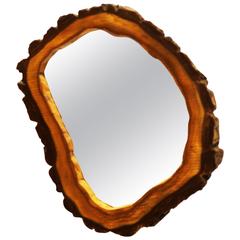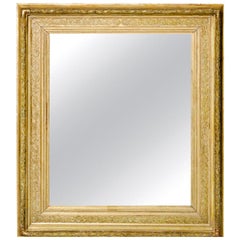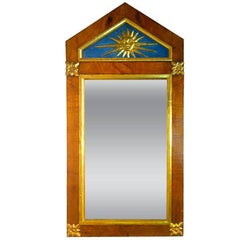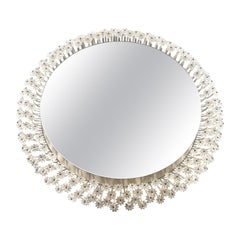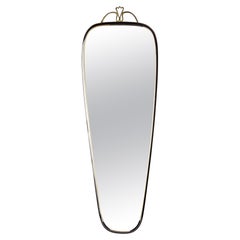Austrian Wall Mirrors
1
243
6
to
12
214
29
249
243
243
62
11
8
7
7
4
3
2
2
1
4
123
116
6
28
77
10
6
1
2
7
1
25
21
8
1
Height
to
Width
to
179
165
165
93
72
13,204
16,575
6,312
3,866
2,529
23
17
7
5
5
Place of Origin: Austrian
Large Cut Crystal Mirror by Bakalowits & Söhne
By Bakalowits & Söhne
Located in Vienna, AT
Vienna from the 1960s
Main frame gold plated all crystals undamaged, electric controled.
Model no.: 3648
In the back fitted for 8 lights
Dimensions: 69.5 x 49 cm
Category
1960s Mid-Century Modern Vintage Austrian Wall Mirrors
Materials
Crystal, Steel, Brass, Gold Plate
Wall Mirror
Located in Vienna, AT
Vienna from 1950s
Walnut wood
Category
1950s Mid-Century Modern Vintage Austrian Wall Mirrors
Materials
Mirror, Walnut
Early 19th Century Giltwood Mirror
Located in Houston, TX
A massive early 19th century polychrome water gilt mirror from Austria.
Measures: 50.5" H x 45" W x 4.5" D.
Category
Early 19th Century Louis XVI Antique Austrian Wall Mirrors
Materials
Wood, Giltwood
19th Century, Austrian Biedermeier Mirror with Carved Water Gilt Gold Sun Burst
Located in Southampton, NY
19th century, Austrian Biedermeier mirror with carved water gilt gold sun burst.
Category
19th Century Antique Austrian Wall Mirrors
Materials
Mahogany
Large illuminated mirror designed by Emil Stejnar for Rupert Nikoll
By Rupert Nikoll, Emil Stejnar
Located in Offenburg, Baden Wurthemberg
Emil Stejnar originally designed his Dandelion chandeliers and also this mirror series in the mid 1950ies. The series was manufactured by Rupert Nikoll for the „Ohne Pause Espresso“,...
Category
Mid-20th Century Mid-Century Modern Austrian Wall Mirrors
Materials
Steel
Wall mirror around 1950s
Located in Wien, AT
Wall mirror around 1950s
Original mirror inside.
The brass is polished and stove enameled
Category
1950s Mid-Century Modern Vintage Austrian Wall Mirrors
Materials
Brass
Rustic Tramp Art Wall Mirror With Unique Corners, Handcarved, Austria circa 1880
Located in Lichtenberg, AT
Extraordinary, unique rustic Tramp Art wall mirror out of Austria from the late 19th century around 1880. Artfully designed and handcarved out of basswood this very special Tramp Art work was crafted in the so called "pyramid technique". This Tramp Art mirror is an unusual one, with darker stained pyramids interrupting the frame and giving it this visual depth. The fantastic looking made exposed/ protruding corners in the shape of drops underline this one of a kind, exceptional design. The mirror glass has been renewed during the restoration process. The wonderful brown surface was sealed...
Category
Late 19th Century Rustic Antique Austrian Wall Mirrors
Materials
Mirror, Softwood
Lucite Wall Mirror Vienna 1976
Located in Wien, AT
Lucite wall mirror vienna 1976
Original condition.
Category
1970s Mid-Century Modern Vintage Austrian Wall Mirrors
Materials
Mirror, Lucite
19th Century Biedermeier Wall Mirror Gold Leaf Plated, Austria circa 1830
Located in Lichtenberg, AT
Exceptional Biedermeier wall mirror from the era around 1830 in Austria. The artfully processed, gold leaf covered frame is adorned by absolute elaborately handcarved corners depicti...
Category
Mid-20th Century Biedermeier Austrian Wall Mirrors
Materials
Gold Leaf
20th Century Rustic Tramp Art Wall Mirror with Gilt Parts, Austria, Dated 1925
Located in Lichtenberg, AT
Marvelous looking rustic Tramp Art wall mirror from the early 20th century in Austria. Dated to 1925, this unusual, very detailed "Tramp Art" work has been artfully created by hand f...
Category
Early 20th Century Rustic Austrian Wall Mirrors
Materials
Mirror, Softwood
Napoleon III Style Tall Austrian Wooden Frame Mercury Mirror and Gold Decoration
Located in Prato, Tuscany
We kindly suggest you read the whole description, because with it we try to give you detailed technical and historical information to guarantee the authenticity of our objects.
Sumptuous and imposing frame in Second Empire style with ground mirror executed with mercury original of the time, the frame was made with precious craftsmanship between 1865 and 1870 in Austria in precious African mahogany feather with processing "lastronatura" and enriched by elegant and refined giltwood decorations at the corners and a finish of golden acanthus leaves along the edge of the mirror. The ground mirror was made with the ancient technique of mercury, which consisted of placing the metal above a series of layers of tin flattened on the glass, the mercury was then smoothed and polished with a special stone and buffered, the mixture thus obtained was called "quicksilver". This technique was developed by the Venetian Master Glassmakers (Master Dal Gallo 1507); the Serenissima placed the process under secret, but over time it leaked out of the city and spread to European countries, first of all, Austria and France. The Napoleon III style (Second Empire) together with the Neo-Renaissance style, belongs to that particular Eclectic period that distinguished European countries in the second half of the 19th century; in short, the Napoleon III style took up the more serious and austere forms of the First Empire, but with the eclecticism that distinguished the period, it made it more graceful, refined and elegant, reflecting and well representing the social, cultural and economic period that Europe was living at the time. The "lastronatura" is a craft technique that was already widespread during the sixteenth century and remained unchanged until the mid-nineteenth century before the Industrial Revolution; the exact term is the Italian "lastronatura" untranslatable into English (possibly slab?), in fact, the "lastronatura" is very different and older than wood-veneer. The technique consisted in cutting by hand with saws the trunks of trees of noble wood (walnut, mahogany, briar, feather, etc..) in many layers with a thickness ranging from 4 to 6 millimeters, which were then applied to the furniture for decorative purposes; the finishing of this process was very complex: the layer of wood was treated with natural earth dissolved in water for the desired tonality, it was antiqued with stone, it was fixed with shellac applied with a brush and finally the polishing was carried out in 12 passages with a cotton pad soaked in shellac, straw-colored oil with powder of pumice stone. The "lastronatura" is not to be confused with the veneer that is modern processing, in fact, the layer of wood is cut by machine and the thickness is below 1 mm., while that of the"lastronatura", as already mentioned, is from 4 to 6 mm. This ancient technique, applied to our frame, has allowed us to enhance the colors, the flaming, and the grain of the precious African feather...
Category
Late 19th Century Napoleon III Antique Austrian Wall Mirrors
Materials
Wood
Black Laquered Oval Wall Mirror Art Nouveau, Austria, circa 1900
Located in Lichtenberg, AT
Stunning oval Art Nouveau wall mirror artfully processed in Vienna/ Austria at the beginning of the 20th century. The slightly grooved solid wooden oval frame from circa 1900 shows a black lacquered surface with an additional hand-polished shellac finish. A simple yet elegant design accented by a fluted...
Category
Early 20th Century Art Nouveau Austrian Wall Mirrors
Materials
Mirror, Wood
19th Century Wall Mirror with Gilt Stucco Bars, Glazed, Austria, circa 1880
Located in Lichtenberg, AT
Unique late 19th century wall mirror from the so-called "Historism" period in Austria around 1880. This wall mirror shows an overlapped substructure made of spruce wood and impresses...
Category
Late 19th Century Antique Austrian Wall Mirrors
Materials
Stucco, Spruce
19th Century Wall Mirror Fruitwood, Austria, circa 1890
Located in Lichtenberg, AT
Late 19th century wall mirror made of fruitwood coming out of Austria, circa 1890. A simple but fantastic designed wall mirror from the so called "Historism" period which shows a bea...
Category
Late 19th Century Antique Austrian Wall Mirrors
Materials
Mirror, Fruitwood
Black Forest Rustic Wall Mirror Hand Carved, Austria, circa 1890
Located in Lichtenberg, AT
From circa 1890 in Austria comes this hand carved wooden Black Forest wall mirror. A simple but elegant "tree trunk" design was created out of basswood, confering this unique charmin...
Category
Early 20th Century Black Forest Austrian Wall Mirrors
Materials
Mirror, Softwood
Large Illuminated Flower Mirror by Emil Stejnar for Rupert Nikoll from, 1950s
By Rupert Nikoll, Emil Stejnar
Located in Vienna, AT
Designed by Emil Stejnar during the early 1950s and manufactured in Austria by Rupert Nikoll. It features an oval mirror, which appears to float, surrounded by a white lacquered meta...
Category
1950s Mid-Century Modern Vintage Austrian Wall Mirrors
Materials
Crystal, Steel
Biedermeier Period Mahogany Mirror
Located in Montreal, QC
Biedermeier period mahogany mirror decorated with burled elm and gilt wood moulding.
Category
19th Century Antique Austrian Wall Mirrors
Recently Viewed
View AllMore Ways To Browse
French Riviera Bamboo
Large Matching Mirrors
1940s Venetian Mirror
Antique Mirror 1930s
Retro Distressed Mirror
Deco Etched Mirror
Modern Danish Wood Mirror
Venetian Mirror With Flowers
Brass Silver Wall Mirror
Gilted Wall Garland
Plaster Framed Mirror
Pair Louis Xvi Mirrors
Italian Arch Mirror
Large Round Wood Mirror
Round Wooden Mirror
Hollywood Regency Gilt Wood Mirror
Antique Solid Wood Mirror
Adam Mirror

